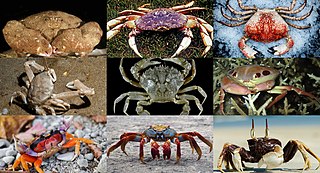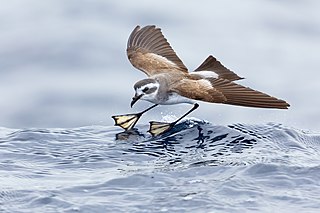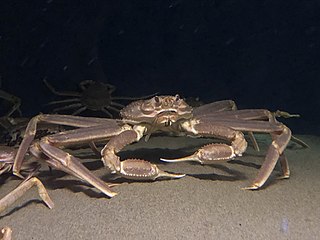
Crabs are decapod crustaceans of the infraorder Brachyura, which typically have a very short projecting tail-like abdomen, usually hidden entirely under the thorax. They live in all the world's oceans, in freshwater, and on land, are generally covered with a thick exoskeleton, and have a single pair of pincers on each arm. They first appeared during the Jurassic period, around 200 million years ago.

The white-faced storm petrel, also known as white-faced petrel or frigate petrel is a small seabird of the austral storm petrel family Oceanitidae. It is the only member of the monotypic genus Pelagodroma. It is widely distributed across the northern and southern hemisphere, especially around the coastal and open ocean waters of southern Australia, New Zealand, Tristan da Cunha, Cabo Verde, the Canary islands and the Selvagens islands.

Cancer pagurus, commonly known as the edible crab or brown crab, is a species of crab found in the North Sea, North Atlantic Ocean, and perhaps the Mediterranean Sea. It is a robust crab of a reddish-brown colour, having an oval carapace with a characteristic "pie crust" edge and black tips to the claws. A mature adult may have a carapace width up to 25 centimetres and weigh up to 3 kilograms. C. pagurus is a nocturnal predator, targeting a range of molluscs and crustaceans. It is the subject of the largest crab fishery in Western Europe, centred on the coasts of the Ireland and Britain, with more than 60,000 tonnes caught annually.

Stenorhynchus seticornis, the yellowline arrow crab or simply arrow crab, is a species of marine crab.

Carcinus maenas is a common littoral crab. It is known by different names around the world. In the British Isles, it is generally referred to as the shore crab, or green shore crab. In North America and South Africa, it bears the name European green crab.

Grapsus grapsus is one of the most common crabs along the western coast of the Americas. It is known as the red rock crab, or, along with other crabs such as Percnon gibbesi, as the Sally Lightfoot crab.

The Jonah crab is a marine brachyuran crab that inhabits waters along the east coast of North America from Newfoundland to Florida. Jonah crabs possess a rounded, rough-edged carapace with small light spots, and robust claws with dark brown-black tips. The maximum reported carapace width for males is 8.7 in (222 mm), while females rarely exceed 5.9 in (150 mm). It is the closest relative to the European brown crab in the Western Atlantic.

Hemigrapsus sanguineus, the Japanese shore crab or Asian shore crab, is a species of crab from East Asia. It has been introduced to several other regions, and is now an invasive species in North America and Europe. It was introduced to these regions by ships from Asia emptying their ballast tanks in coastal waters.

Callinectes similis, sometimes called the lesser blue crab or dwarf crab, is a West Atlantic species of blue crab. It was described by Austin B. Williams in 1966.

Minuca pugnax, commonly known as the Atlantic marsh fiddler crab, is a species of fiddler crab that lives on north-western shores of the Atlantic Ocean.

Pachygrapsus marmoratus is a species of crab, sometimes called the marbled rock crab or marbled crab, which lives in the Black Sea, the Mediterranean Sea and parts of the Atlantic Ocean. It is dark violet brown, with yellow marbling, and with a body up to 36 millimetres (1.4 in) long. A semiterrestrial omnivore, it feeds on algae and various animals including mussels and limpets.

Xantho poressa, the jaguar round crab, is a species of crab from the eastern Atlantic Ocean. It is one of four species in the genus Xantho.

Xantho hydrophilus, the furrowed crab or Montagu's crab, is a species of crab from the family Xanthidae. It is yellowish-brown and grows to a carapace width of 70 mm (2.8 in). It is a nocturnal omnivore that lives in shallow marine waters from western Scotland to the Cape Verde Islands.

Inachus phalangium, Leach's spider crab, is a species of crabs from the north-eastern Atlantic Ocean and Mediterranean Sea. It is up to 20.5 mm (0.81 in) wide, and is very similar to other species in the genus Inachus.

Chionoecetes opilio, a species of snow crab, also known as opilio crab or opies, is a predominantly epifaunal crustacean native to shelf depths in the northwest Atlantic Ocean and north Pacific Ocean. It is a well-known commercial species of Chionoecetes, often caught with traps or by trawling. Seven species are in the genus Chionoecetes, all of which bear the name "snow crab". C. opilio is related to C. bairdi, commonly known as the tanner crab, and other crab species found in the cold, northern oceans.

Pirimela is a genus of crab containing a single species, Pirimela denticulata.

Helicolenus dactylopterus, blackbelly rosefish, bluemouth rockfish, and bluemouth seaperch, is a species of marine ray-finned fish belonging to the subfamily Sebastinae which is classified within the family Scorpaenidae. This Atlantic species is a typical sit-and-wait predator with a highly cryptic coloration.

Dyspanopeus sayi is a species of mud crab that is native to the Atlantic coast of North America. It has also become established outside its native range, living in Swansea Docks since 1960, the Mediterranean Sea since the 1970s, the North Sea since 2007 and the Black Sea since 2010. It can reach a carapace width of 20 mm (0.8 in), and has black tips to its unequal claws. It feeds on bivalves and barnacles, and is in turn eaten by predators including the Atlantic blue crab, Callinectes sapidus. Eggs are produced from spring to autumn, the offspring reach sexual maturity the following summer, and individuals can live for up to two years. The closest relative of D. sayi is D. texanus, which lives in the Gulf of Mexico; the two species differ in subtle features of the genitalia and the last pair of walking legs.

Polybius henslowii is a species of crab, the only species in the genus Polybius. It is a capable swimmer and feeds in open water in the north-east Atlantic Ocean and western Mediterranean Sea.

Geryon trispinosus is a species of crab that lives in deep water in the north-eastern Atlantic Ocean.




















